Citroen C4 PICASSO RHD 2015 1.G Owner's Manual
Manufacturer: CITROEN, Model Year: 2015, Model line: C4 PICASSO RHD, Model: Citroen C4 PICASSO RHD 2015 1.GPages: 428, PDF Size: 10.09 MB
Page 121 of 428
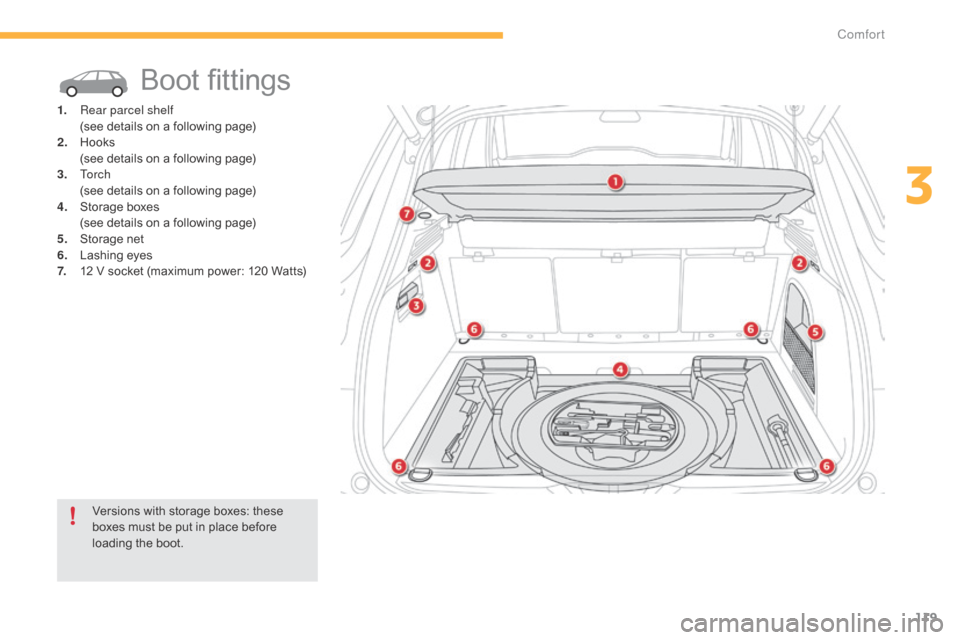
119
Boot fittings
1. Rear parcel shelf (see details on a following page)
2.
H
ooks
(
see details on a following page)
3.
To r c h
(
see details on a following page)
4.
St
orage
b
oxes
(
see details on a following page)
5.
St
orage
n
et
6.
L
ashing eyes
7.
1
2 V socket (maximum power: 120 Watts)
Versions
with storage boxes: these
b
oxes must be put in place before
l
oading the boot.
3
Comfort
Page 122 of 428
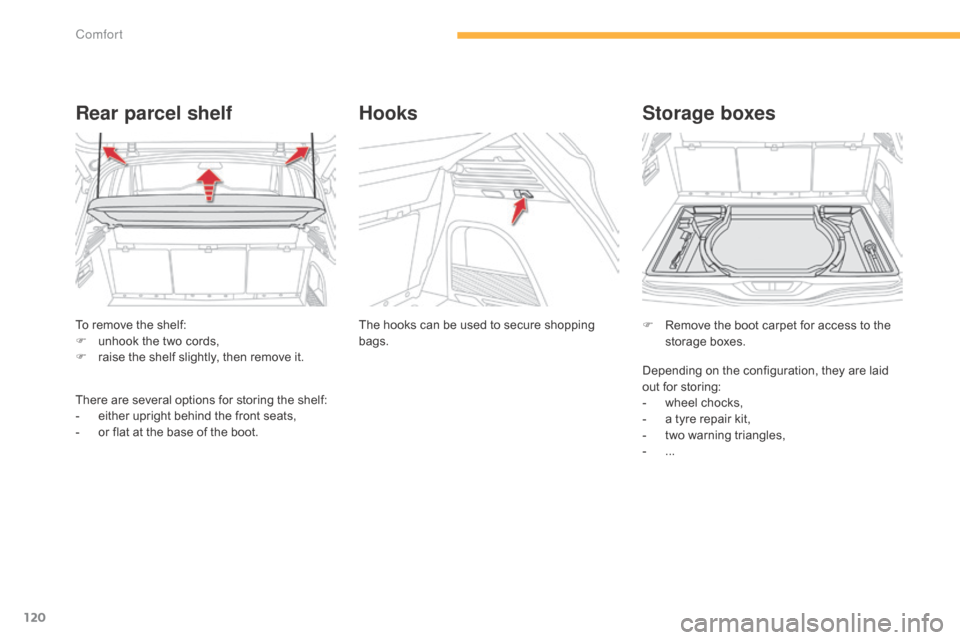
120
To remove the shelf:
F u nhook the two cords,
F
r
aise the shelf slightly, then remove it.
Rear parcel shelf
There are several options for storing the shelf:
- e ither upright behind the front seats,
-
o
r flat at the base of the boot.The
hooks can be used to secure shopping
b
ags.
Hooks
F Remove
the boot carpet for access to the s
torage bo xes.
Storage boxes
Depending on the configuration, they are laid out for storing:
-
w
heel chocks,
-
a
tyre repair kit,
-
t
wo warning triangles,
-
...
Comfort
Page 123 of 428
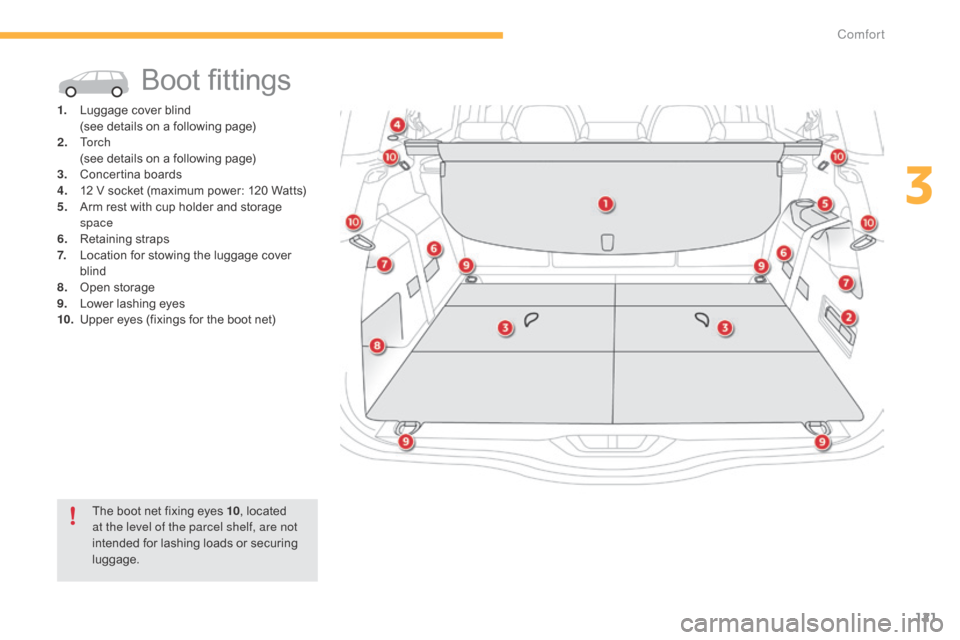
121
Boot fittings
1. Luggage cover blind (
see details on a following page)
2.
T
o r c h
(
see details on a following page)
3.
C
oncertina
b
oards
4.
1
2 V socket (maximum power: 120 Watts)
5.
A
rm rest with cup holder and storage
spa
ce
6.
R
etaining
s
traps
7.
L
ocation for stowing the luggage cover
b
lind
8.
O
pen
s
torage
9.
L
ower lashing eyes
10.
U
pper eyes (fixings for the boot net)
The
boot net fixing eyes 10,
located
a
t the level of the parcel shelf, are not
intended
for lashing loads or securing
l
uggage.
3
Comfort
Page 124 of 428
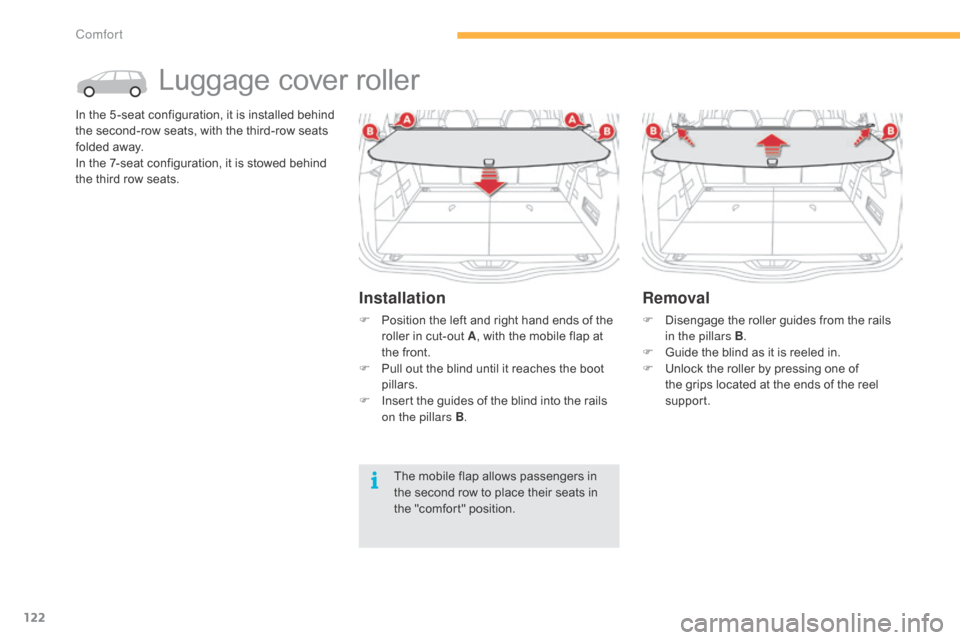
122
Luggage cover roller
In the 5 -seat configuration, it is installed behind t
he second-row seats, with the third-row seats
f
olded away.
In
the 7-seat configuration, it is stowed behind
t
he third row seats.
Installation
F Position the left and right hand ends of the r
oller in cut-out A,
with the mobile flap at
t
he front.
F
P
ull out the blind until it reaches the boot
p
illars.
F
I
nsert the guides of the blind into the rails
o
n the pillars B .
Removal
F Disengage the roller guides from the rails i
n the pillars B .
F
G
uide the blind as it is reeled in.
F
U
nlock the roller by pressing one of
t
he grips located at the ends of the reel
sup
port.
The
mobile
flap
allows
passengers
in
t
he
second
row
to
place
their
seats
in
t
he
"comfort"
position.
Comfort
Page 125 of 428
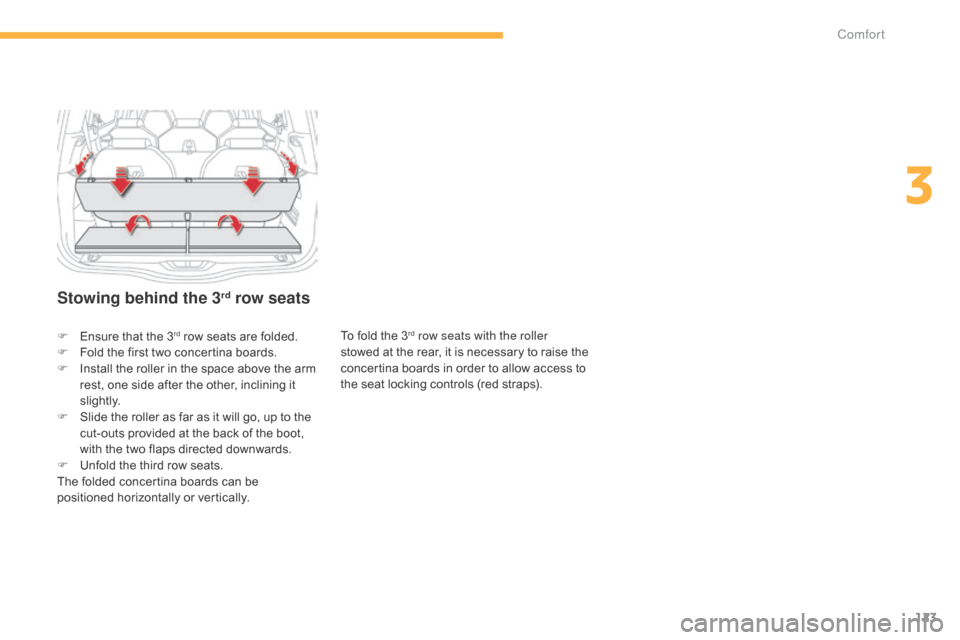
123
Stowing behind the 3rd row seats
To fold the 3rd row seats with the roller
stowed
at
the
rear, it is necessary to raise the
c
oncertina
boards in order to allow access to
t
he
seat
locking controls (red straps).
F
E
nsure
that
the
3rd row seats are folded.
F
F
old
the
first
two
concertina boards.
F
I
nstall
the
roller
in
the space above the arm
r
est,
one
side
after the other, inclining it
s
li g ht l y.
F
S
lide
the
roller
as
far as it will go, up to the
c
ut-outs
provided
at the back of the boot,
w
ith
the
two
flaps
directed downwards.
F
U
nfold
the
third
row seats.
The
folded
concertina
boards can be
p
ositioned
horizontally or vertically.
3
Comfort
Page 126 of 428
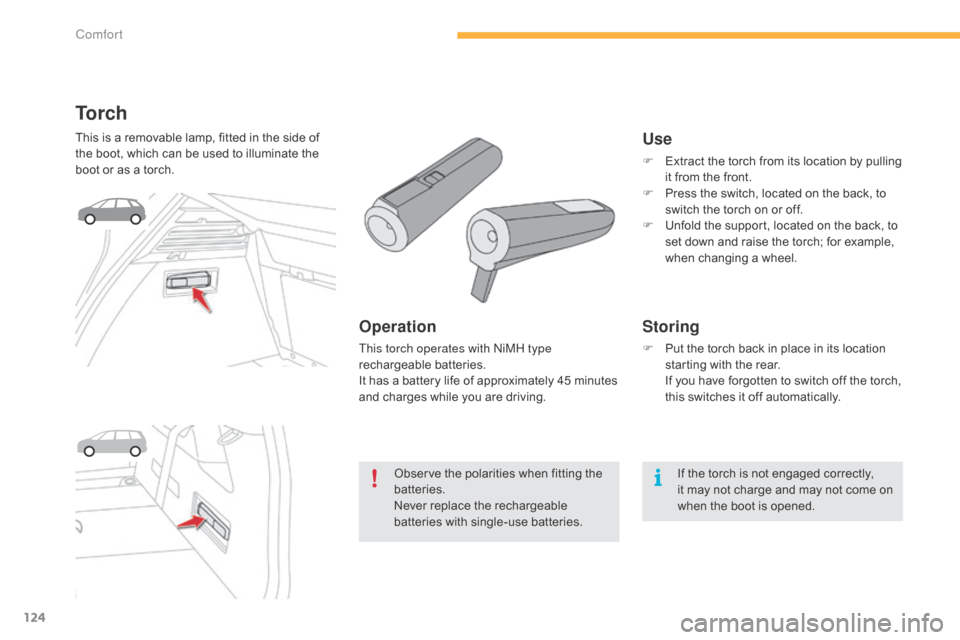
124
To r c h
This is a removable lamp, fitted in the side of the boot, which can be used to illuminate the
b
oot or as a torch.
Operation
This torch operates with ni MH type
rechargeable b atteries.
It
has a battery life of approximately 45 minutes
a
nd charges while you are driving.
Use
F Extract the torch from its location by pulling i
t from the front.
F
P
ress the switch, located on the back, to
s
witch the torch on or off.
F
U
nfold the support, located on the back, to
s
et down and raise the torch; for example,
w
hen changing a wheel.
Storing
F Put the torch back in place in its location s
tarting with the rear.
I
f you have forgotten to switch off the torch,
t
his switches it off automatically.
If
the torch is not engaged correctly,
it
may not charge and may not come on
w
hen the boot is opened.
Observe
the
polarities
when
fitting
the
b
atteries.
Never
replace
the
rechargeable
b
atteries
with
single-use
batteries.
Comfort
Page 127 of 428
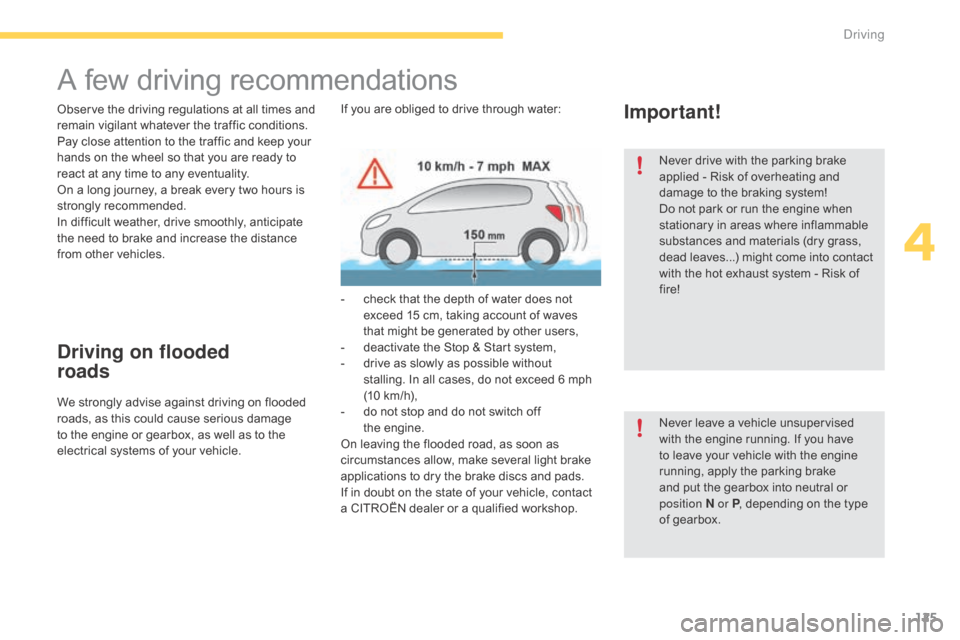
125
A few driving recommendations
Observe the driving regulations at all times and remain vigilant whatever the traffic conditions.
Pay
close attention to the traffic and keep your
h
ands on the wheel so that you are ready to
r
eact at any time to any eventuality.
On
a long journey, a break every two hours is
s
trongly
re
commended.
In
difficult weather, drive smoothly, anticipate
t
he need to brake and increase the distance
f
rom other vehicles.
Driving on flooded
roads
We strongly advise against driving on flooded roads, as this could cause serious damage
t
o the engine or gearbox, as well as to the
e
lectrical systems of your vehicle.If
you are obliged to drive through water:
-
c
heck that the depth of water does not
e
xceed 15 cm, taking account of waves
t
hat might be generated by other users,
-
d
eactivate the Stop & Start system,
-
d
rive as slowly as possible without
s
talling. In all cases, do not exceed 6 mph (
10 km/h),
- d o not stop and do not switch off
t
he engine.
On
leaving the flooded road, as soon as
c
ircumstances allow, make several light brake
a
pplications to dry the brake discs and pads.
If
in doubt on the state of your vehicle, contact
a
CITROËN dealer or a qualified workshop.
Important!
Never drive with the parking brake applied - Risk of overheating and
d
amage to the braking system!
Do
not park or run the engine when
s
tationary in areas where inflammable
s
ubstances and materials (dry grass,
d
ead leaves...) might come into contact
w
ith the hot exhaust system - Risk of
f
ire!
Never
leave a vehicle unsupervised
w
ith the engine running. If you have
t
o leave your vehicle with the engine
r
unning, apply the parking brake
a
nd put the gearbox into neutral or
p
osition
N or P,
depending on the type
o
f gearbox.
4
Driving
Page 128 of 428
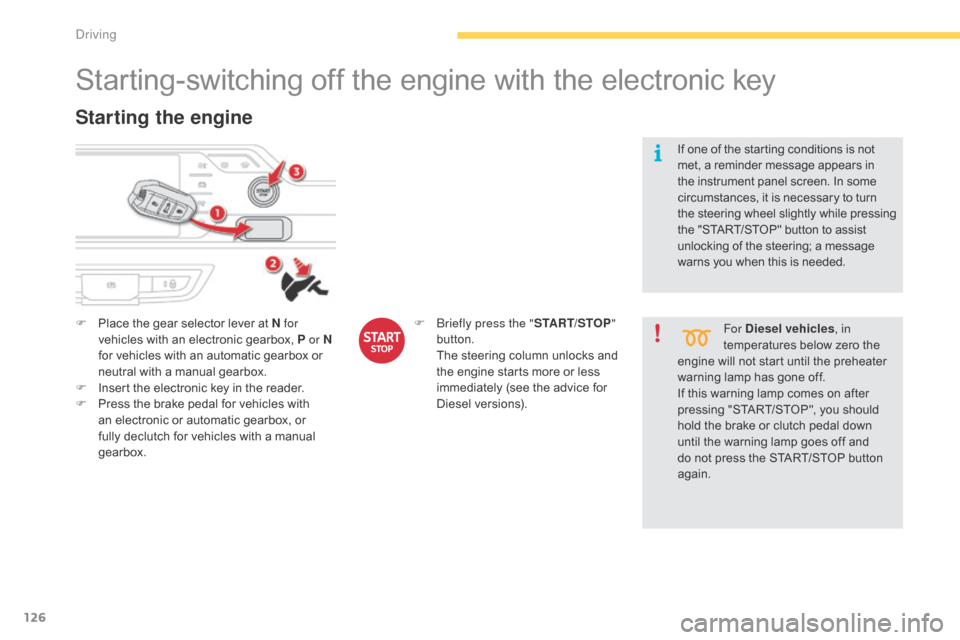
126
Starting-switching off the engine with the electronic key
F Place the gear selector lever at N for
vehicles with an electronic gearbox, P or N
for
vehicles with an automatic gearbox or
n
eutral with a manual gearbox.
F
I
nsert the electronic key in the reader.
F
P
ress the brake pedal for vehicles with
a
n electronic or automatic gearbox, or
f
ully declutch for vehicles with a manual
g
earbox.
Starting the engine
For Diesel vehicles , in
temperatures below zero the
e
ngine
will not start until the preheater
w
arning
lamp has gone off.
If
this
warning lamp comes on after
p
ressing "START/STOP", you should
h
old
the
brake or clutch pedal down
u
ntil
the
warning lamp goes off and
d
o
not
press the START/STOP button
ag
ain.
If
one
of
the starting conditions is not
m
et,
a
reminder message appears in
t
he
instrument panel screen. In some
c
ircumstances, it is necessary to turn
t
he
steering wheel slightly while pressing
t
he
"START/STOP" button to assist
u
nlocking of the steering; a message
w
arns
you when this is needed.
F
br
iefly press the "
START/STOP"
button.
T
he
steering
column
unlocks
and
t
he
engine
starts
more
or
less
i
mmediately
(see
the
advice
for
D
iesel
v
ersions).
Driving
Page 129 of 428

127
Electronic key left in the
reader
If the electronic key is left in the reader, on opening the driver's door a message
a
ppears to warn you.
In
the event of an emergency only,
t
he engine can be switched off
w
ithout any conditions. To do this,
p
ress the "START/STOP" button for
a
bout three seconds.
In this case the steering column locks
a
s soon as the vehicle stops.
Emergency stop
F Immobilise
the vehicle.
F P lace the gear selector lever at N for
vehicles
with an electronic gearbox, P or N
for
an automatic gearbox, or neutral with a
m
anual
g
earbox.
Switching off the engine
If the vehicle is not immobilised, the engine will not stop.
F
b
r
iefly press the "
START/STOP"
button.
T
he engine stops and the
s
teering column locks.
F
R
emove the electronic key from the reader.
Switching off the engine leads to a loss
o
f braking assistance.
4
Driving
Page 130 of 428
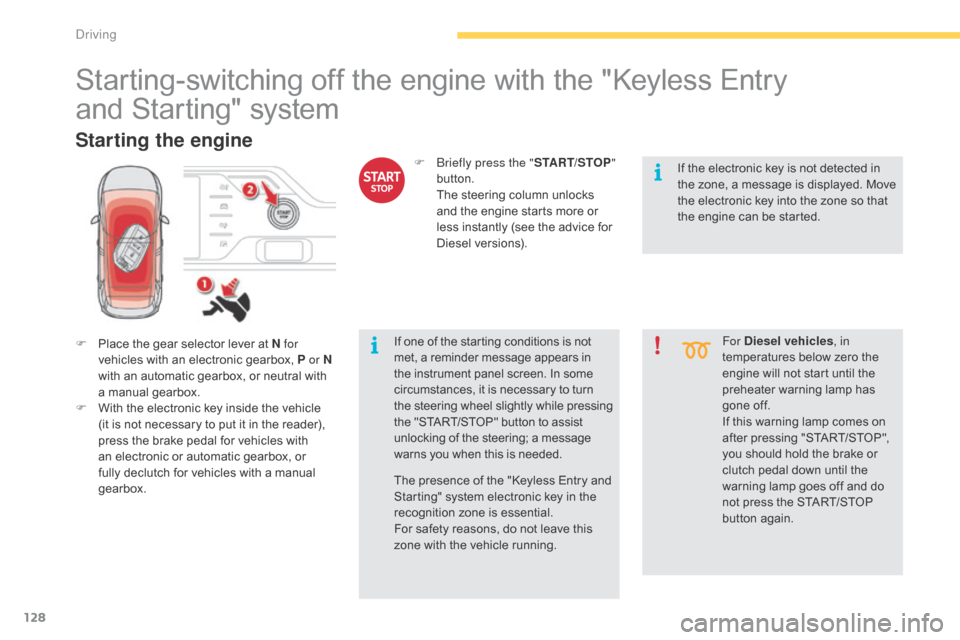
128
Starting-switching off the engine with the "Keyless Entry
a
nd Starting" system
F Place the gear selector lever at N for
vehicles with an electronic gearbox, P or N
with
an automatic gearbox, or neutral with
a m
anual
g
earbox.
F
W
ith the electronic key inside the vehicle
(
it is not necessary to put it in the reader),
p
ress the brake pedal for vehicles with
a
n electronic or automatic gearbox, or
f
ully declutch for vehicles with a manual
g
earbox. For Diesel vehicles
, in
temperatures below zero the
e
ngine will not start until the
p
reheater warning lamp has
g
one off.
If
this warning lamp comes on
a
fter pressing "START/STOP",
y
ou should hold the brake or
c
lutch pedal down until the
w
arning lamp goes off and do
n
ot press the START/STOP
bu
tton
ag
ain.
Starting the engine
If one of the starting conditions is not met, a reminder message appears in t
he instrument panel screen. In some
c
ircumstances, it is necessary to turn
t
he steering wheel slightly while pressing
t
he "START/STOP" button to assist
u
nlocking of the steering; a message
w
arns you when this is needed.
F
b
r
iefly press the "
START/STOP"
button.
T
he steering column unlocks
a
nd the engine starts more or
l
ess instantly (see the advice for
D
iesel
v
ersions).
The presence of the "Keyless Entry and
S
tarting" system electronic key in the
r
ecognition zone is essential.
For
safety reasons, do not leave this
z
one with the vehicle running. If
the electronic key is not detected in
t
he zone, a message is displayed. Move
t
he electronic key into the zone so that
t
he engine can be started.
Driving